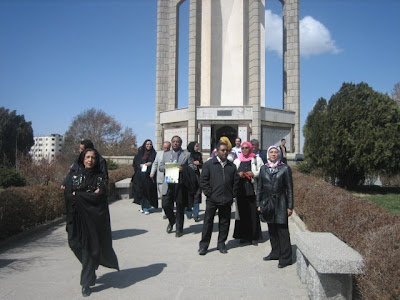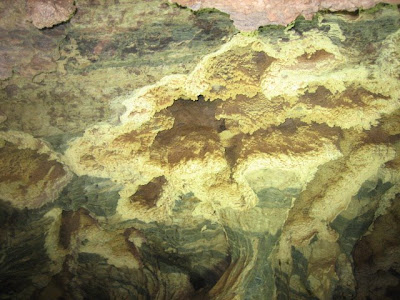physician, philosopher, writer and father of medicine
Salaam,
During March 2007, we had the opportunity to visit the province of Hamedan. The first trip was organized by the Commonwealth group in Tehran, just before Nowrooz. Later on during the Nowrooz holiday, we organized another visit with our staff and family. (My first trip to this province was in 2006 with the Diplomatic Ladies Group of Tehran).
The provincial capital, also called Hamedan, is located about 375 km south west of Tehran at the foot of Mt. Alvand in the Zagros mountain range. It took us about four hours drive from Tehran to reach the city via Saveh highway. It can also be reached via Qazvin in the west. But it was worth the visit as the province has a lot to offer for discerning visitors.
Known in ancient time as Ecbatana, Hamedan is the oldest Iranian city and one of the oldest cities in the world. During the Media era, the dawn of Iranian history, the city was called Hegmataaneh. However according to the Greeks scriptures, the city was named Ekbaataan. According to the legendary Persian poet Ferdowsi, Ecbatana was founded by the mythical King Jamshid. So it was here that the first Median capital, Ecbatana or Place of Assembly, was founded in 673 BC. In 549 BC Cyrus the Great defeated the last Median king, and Ecbatana became the summer residence of the Achaemenian Dynasty court. Hamedan briefly became the capital of the Seljuk Dynasty in the 12th century, destroyed by the Mongol a century later, and again by Tamerlane in 1386.
At the height of its glory, Hamedan was described as one of the most opulent cities. It had splendid palaces, buildings plated with precious metals, and seven layers of town walls, of which the inner two were coated in gold and silver.
Some of the relics have been uncovered and are on display to the public in the city’s mausoleums. All this indicates that Hamedan has a huge share in the establishment of the human civilization.
During our tours of the city and the surrounding province, we managed to visit some of the monuments, ancient and natural sites which make the city and the province famous for and worthy of interest...
Wassalam.
 one of the city's top hotels...
one of the city's top hotels... dinner at Baba Taher hosted by the gov. general
dinner at Baba Taher hosted by the gov. generalThe Tomb of Ibn Sina, (Abu Ali Sina by the Persians and Avicenna by the western world), a tower composed of a conical roof held up by twelve tall pillars around an empty central space, in the city of Hamedan. Born in Khormassin, near Bukhara (now Uzbekistan) around 980 AD, and died in Hamedan in 1037 AD. One of the most influential scholars both in the Islamic world and in the west.






Baba Taher, the grandson of Omar Khayyam, was a famous Sufi poet who lived between the 10th and 13th centuries. His tomb is located in the north of the city. Considered by his contemporaries as one of the most eminent, erudite mystics and sentimentalists of his time, a reputation he has held in the affection of his countrymen to the present day...





Hamedan's most curious monument is a Jewish mausoleum reputed to contain the tombs of Esther and Mardochius (Mordechai). According to tradition, Esther the Jewish wife of Achaemenian king Xerxes (485-465 BC) emigrated to Persia and succeeded in securing royal protection for the followers of her faith, and with the help of her uncle Mardochius the establishment of Jewish colonies throughout the Persian empire. However the tomb is also attributed to a Shushan, a much later Jewish Sassanian queen, who is said to have persuaded her husband Yazdgerd I, to allow a Jewish colony at Hamedan in the early 5th century AD.


 inside the snyogogue
inside the snyogogueRemnants of the Old City of Ecbatana...


Ganj-nameh...The Treasure Book...
Located on Mount Alvand about 5 km from the city, this famous stone carving is a pair of Achaemenian rock carvings from Darius (on the left) and his son Xerxes I. They have been engraved on Alvand Mountain, at the extreme end of the beautiful valley of Abbas Abad. The tabloids ordered carved by Darius the Great and Xerxes, carry the two supplications of Ahura Mazda and the prayer for the preservation of the country.







The village of Lalehjin, about 32 km north of Hamedan, is famous for ceramic arts, particularly with the torquoise glaze for which the region is known.



This is one of the most beautiful natural limestone caves in the world which goes 500 metres into the mountain. Located about 100 km north of Hamedan city, it was discovered only 50 years ago by a local shepherd looking for a lost goat. The cave is about 60 km long. In some places its height goes up to 40 metres high with a width of 2-15 metres and the underground lakes are up to 8 metres deep. Some of the various rock formations have been given names such as "eagle claw", "grape clusters" and "stature of liberty." It contains several lakes, halls and corridors. One can enjoy and go around through the cave by recreational boats with a guide.

























